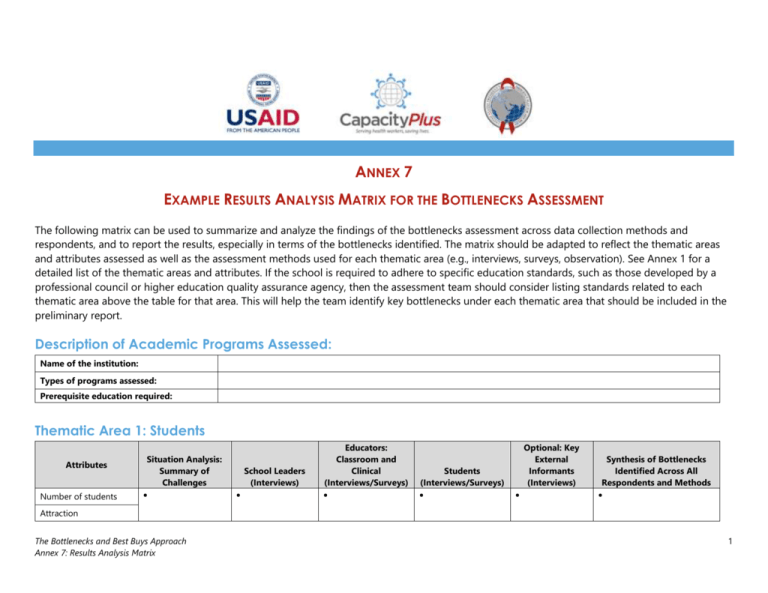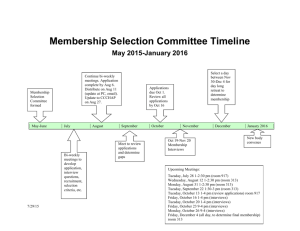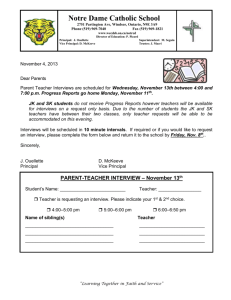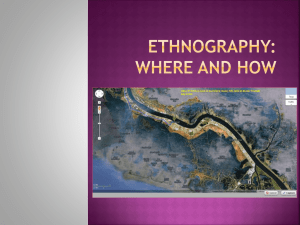Example Results Analysis Matrix for the Bottlenecks Assessment
advertisement

ANNEX 7 EXAMPLE RESULTS ANALYSIS MATRIX FOR THE BOTTLENECKS ASSESSMENT The following matrix can be used to summarize and analyze the findings of the bottlenecks assessment across data collection methods and respondents, and to report the results, especially in terms of the bottlenecks identified. The matrix should be adapted to reflect the thematic areas and attributes assessed as well as the assessment methods used for each thematic area (e.g., interviews, surveys, observation). See Annex 1 for a detailed list of the thematic areas and attributes. If the school is required to adhere to specific education standards, such as those developed by a professional council or higher education quality assurance agency, then the assessment team should consider listing standards related to each thematic area above the table for that area. This will help the team identify key bottlenecks under each thematic area that should be included in the preliminary report. Description of Academic Programs Assessed: Name of the institution: Types of programs assessed: Prerequisite education required: Thematic Area 1: Students Attributes Number of students Situation Analysis: Summary of Challenges School Leaders (Interviews) Educators: Classroom and Clinical (Interviews/Surveys) Students (Interviews/Surveys) Optional: Key External Informants (Interviews) Synthesis of Bottlenecks Identified Across All Respondents and Methods Attraction The Bottlenecks and Best Buys Approach Annex 7: Results Analysis Matrix 1 Optional: Key External Informants (Interviews) Synthesis of Bottlenecks Identified Across All Respondents and Methods Note: Educators are all those involved in the delivery of the curriculum, including classroom teachers and clinical preceptors or supervisors Educators: Optional: Key Situation Analysis: Classroom and External Attributes Summary of School Leaders Clinical Students Informants Challenges (Interviews) (Interviews/Surveys) (Interviews/Surveys) (Interviews) Quantity Synthesis of Bottlenecks Identified Across All Respondents and Methods Attributes Situation Analysis: Summary of Challenges School Leaders (Interviews) Educators: Classroom and Clinical (Interviews/Surveys) Students (Interviews/Surveys) Selection Admissions Retention/throughput Graduation, licensure, and deployment Thematic Area 2: Educators Development (to become educators) Attraction and recruitment Retention Quality/expertise in subject matter Quality/ability to teach Continuing professional development (CPD) Research The Bottlenecks and Best Buys Approach Annex 7: Results Analysis Matrix 2 Thematic Area 3: Management Attributes Financial management Situation Analysis: Summary of Challenges Educators: Classroom and Clinical (Interviews/Surveys) School Leaders (Interviews) Students (Interviews/Surveys) Optional: Key External Informants (Interviews) Synthesis of Bottlenecks Identified Across All Respondents and Methods Absorptive capacity Leadership and governance Human resources management Monitoring, selfassessment and evaluation Thematic Area 4: Facilities and Infrastructure Situation Analysis: Summary of Challenges Attributes Lecture rooms/ classrooms Skills labs/ demonstration rooms/ clinical simulation labs Library or learning resource center School Leaders (Interviews) Educators: Classroom and Clinical (Interviews/ Surveys) Students (Interviews/ Surveys) Optional: Key External Informants (Interviews) Optional: Structured Observation Synthesis of Bottlenecks Identified Across All Respondents and Methods Computer room or lab Lodging/dormitories Canteen/cafeterias Internet Security The Bottlenecks and Best Buys Approach Annex 7: Results Analysis Matrix 3 Thematic Area 5: Materials and Equipment Situation Analysis: Summary of Challenges Attributes Skills lab School Leaders (Interviews) Educators: Classroom and Clinical (Interviews/ Surveys) Students (Interviews/ Surveys) Optional: Key External Informants (Interviews) Optional: Structured Observation Synthesis of Bottlenecks Identified Across All Respondents and Methods Clinical practice Textbooks, journals, and learning materials Computers and projectors Thematic Area 6: Curriculum Attributes Adapted to population health needs and national HRH policies and strategies Use of information and communication technologies/ eLearning Learning methods/ approaches Development of practical skills Situation Analysis: Summary of Challenges School Leaders (Interviews) Educators: Classroom and Clinical (Interviews/Surveys) Students (Interviews/Surveys) Optional: Key External Informants (Interviews) Synthesis of Bottlenecks Identified Across All Respondents and Methods Research Student assessment The Bottlenecks and Best Buys Approach Annex 7: Results Analysis Matrix 4 Thematic Area 7: Clinical Practice Situation Analysis: Summary of Challenges Attributes Assessed Sites/facilities School Leaders (Interviews) Educators: Classroom and Clinical (Interviews/ Surveys) Students (Interviews/ Surveys) Optional: Key External Informants (Interviews) Optional: Structured Observation Synthesis of Bottlenecks Identified Across All Respondents and Methods Supervision/instruction Duration Thematic Area 8: Quality Assurance Attributes Situation Analysis: Summary of Challenges School Leaders (Interviews) Educators: Classroom and Clinical (Interviews/Surveys) Optional: Key External Informants (Interviews) Students (Interviews/Surveys) Synthesis of Bottlenecks Identified Across All Respondents and Methods Accreditation of educational institutions Licensure or certification of graduates Scopes of practice Thematic Area 9: Partnership and Exchange Attributes Faculty exchange Situation Analysis: Summary of Challenges School Leaders (Interviews) Educators: Classroom and Clinical (Interviews/Surveys) Students (Interviews/Surveys) Optional: Key External Informants (Interviews) Synthesis of Bottlenecks Identified Across All Respondents and Methods Student exchange Twinning, networks, or partnerships with other schools The Bottlenecks and Best Buys Approach Annex 7: Results Analysis Matrix 5 Attributes Situation Analysis: Summary of Challenges School Leaders (Interviews) Educators: Classroom and Clinical (Interviews/Surveys) Students (Interviews/Surveys) Optional: Key External Informants (Interviews) Synthesis of Bottlenecks Identified Across All Respondents and Methods Collaboration or partnership within the same institution (i.e., between faculties) Collaboration or partnerships with clinical facilities and communities Partnerships with professional councils and associations The Bottlenecks and Best Buys Approach Annex 7: Results Analysis Matrix 6







